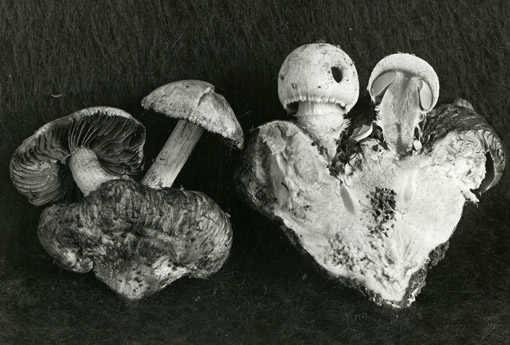
Stropharia epimyces
CUP-A-005424a
Here's a curious mushroom that's parasitic on another mushroom. The lumpen mass under the mushrooms in this photo is a remnant of the host, which doesn't form correctly or disperse its spores when the parasite is present.
In Atkinson's photo, the parasite is growing on Copinopsis atramentaria, which you might know by its old name, Coprinus atramentarius, or its common names, tippler's bane or the alcohol inky cap.
Today we know that eating a meal of alcohol inkies is just fine UNLESS one also partakes of an alcoholic beverage. A toxin (coprine) found in the mushroom blocks our bodies' ability to break down alcohol, resulting in a flushing, sweating, heart poundingly toxic reaction.
2. G.F. Atkinson, 1907. A mushroom parasitic on another mushroom. Plant World 10:121-.
3. C.H. Peck, 1884. Report of the Botanist. Annual Report of the New York State Museum of Natural History, 35: 125-164 (see p. 133).
Psathyrella epimyces growing from parasitized aclohol inkies.
Atkinson described this parasite in 19021, as Stropharia coprinophila, believing he was the first to see it. However, C.H. Peck had earlier named it Panaeolus epimyces, giving it a terse description, without knowing the identity of the host. Peck's earlier name sticks, but Atkinson disagreed with Peck about which genus it belonged in. In 19072 he transferred Peck's species to Stropharia, and it became Stropharia epimyces (Peck) G.F. Atk. Peck and Atkinson had a long and friendly relationship. In 1972 Alexander Smith moved the species again, and it is now known as Psathyrella epimyces (Peck) A.H. Smith. Species hop from genus to genus over the years as we refine our understanding of them, and tighten up our classification system. No hard feelings.
Sparing no detail, Atkinson wrote:2 "There is one curious thing in connection with the taste of this Stropharia parasite of the Coprinus. The taste is very similar to that of its host, the Coprinus atramentarius, a slight nutty taste as of fresh hickory nuts before they have dried or quite ripened. Mushrooms sometimes have a flavor or odor suggestive of their environment. Dr. Peck says that Agaricus maritimus has an odor suggestive of the sea. Several years ago I received specimens of Volvaria speciosa from Lansing, Michigan. They were found growing in a potato patch. On decaying the fungi had an odor of rotten potatoes."
